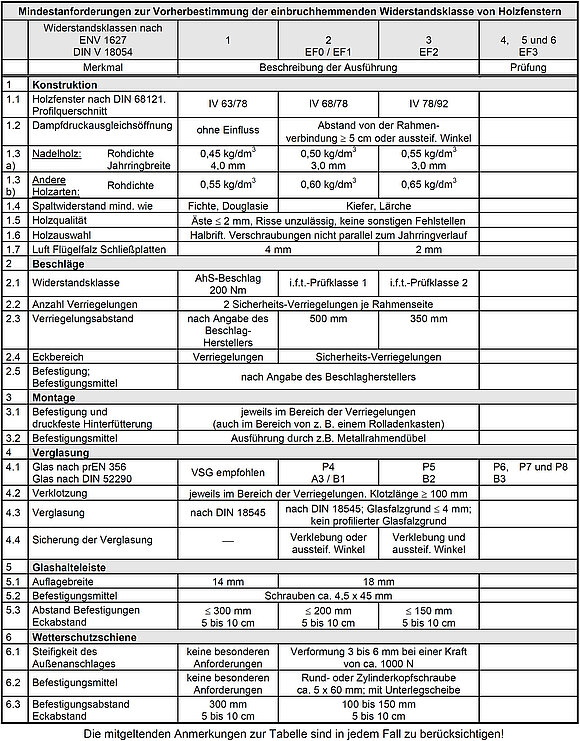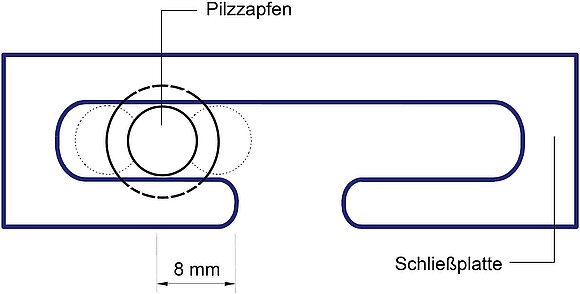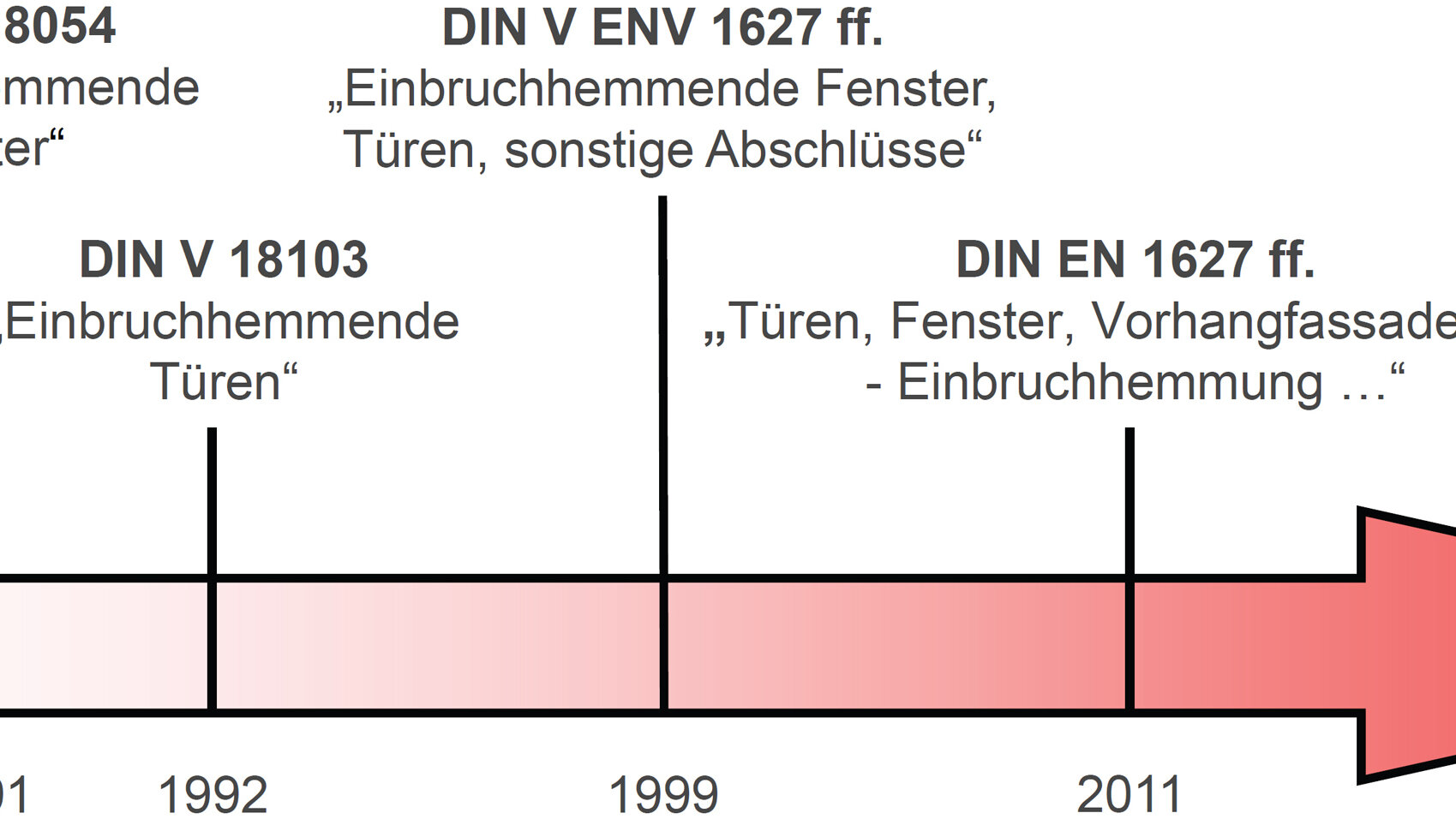Reading time: 1 minute
In 2016, the Insitut für Fenstertechnik e.V. (ift Rosenheim) is celebrating its 50th anniversary. According to the motto ‘ift Rosenheim – 50 years of service to the industry’, the technical development is presented in a ten-part series of articles. The individual articles are reflecting timeframes of 5 years from founding of the institute. They enable a short glance at the events at that time, take up as a key aspect a pioneering research project at that time, summarize goals, contents as well as results, then illustrate the further development as well as the impact thereof on the industry, and the current state of the art.
Burglar Resistant Building Components – An Inevitable Trend
Situation at Doors and Windows from the 70s
The origins of the development of burglar resistant building components lie already in the 70s. In 1975, the first conversation with the Criminal Investigation Department, the lock industry and the door industry were made after series of tests on doors at ift Rosenheim. They realized that the burglar resistance could only be given if all single components (strike plate, lock, cylinder, hinges, door leaf) maintain the same security level. In 1989, the draft standard of DIN 18103 [2] for burglar resistant doors was presented.
Almost at the same time, ift Rosenheim examined the burglar resistant characteristic of customary window constructions. A conventional window could not withstand the fundamental requirements of DIN 18103. The test requirements had to be adapted to the properties of the windows. This resulted in the ift-Guideline for testing and evaluating of burglar resistant windows [3], published in 1987. This finally led to the prestandard DIN V 18054 for burglar resistant windows [4].
Aim of the Research Project
Design criteria should be generated in order to easily classify burglar resistant windows in the resistance classes of the DIN V 18054. Tests were made at the complete window according to DIN V 18054 as well as component and single component tests within the research project “Design features for burglar resistant timber windows” [5]. Aim was an overview of all necessary design criteria for burglar resistant timber windows.
Results of Research Project and Perspective
Basis were the requirements of DIN V 18054. However, the standardisation situation has changed multiple times in the course of the work of the research project. The evaluation of burglar resistant timber windows were made in the final report according to DIN V 18054. The requirements were formulated in such a way that they were in accordance with the resistance classes 1 to 6 of the European prestandards ENV 1627 to 1630.
A direct allocation of constructions to the resistance classes defined in the standards was possible. The allocation to the classes EF0 to EF2 defined in DIN V 18054 was clear. A classification of the burglar resistant timber windows could be made in resistance classes 1 to 3 according to ENV 1627. Due to combinations of various additional measures, the next resistance class could be reached.
The minimum requirements for wooden windows was compiled in table 1. Thus, the manufacturer of wooden windows were able to allocate their windows already in the planning stage to a resistance class and/or built its constructions accordingly.

Impact of results

Development in practice Praxis
Until the mid-90s, there was a dramatic increase in the number of burglaries, which furnately decreased in the following years. However, too many burglary delicts were present.
The commencement of the standards series DIN V ENV 1627 [6] et seqq. in 1999 was a milestone in the development of the normative basis for the test of burglar resistant components In September 2011, the transfer of the prestandard in the currently valid DIN EN 1627 [7] et seqq. (image 1) was made.
Intervention point of the locking mechanism as influencing factor
The principles apply also for the burglar resistance of windows that all single components have to observe the same security level. Special attention has to be paid to the hardware, as it connects two components to one construction product, which was taken into account in the research project [5].
In particular, the tensile test are highly relevant for the factory production control as well as for the certification. A common point of failure is the engagement of the mushroom head in the strike plate. For the tensile test, the engagement of the mushroom head was planned to be 8 mm as a realistic average value. The minimum engagement should still be adhered for every locking point to ensure the performance of hardware and window elements (Image 2).

Closing of gaps by retrofitting
The development of appropriate testing standards provided opportunities to create a retrofitted protection in already installed windows and doors. The properties of retrofitting measures of windows and doors could be verified by DIN 18104-1 [8] for surface-mounted retrofit products as well as by DIN 18104-2 [9] for retrofit products embedded in rebate.
Thus a very good security level can be created, without having initially commissioned a burglar resistant version. Noteworthy is that a new market has developed in the last few years due to this “niche”. However, a tested and certified construction product should always preferred!
Current status
Development with its good and bad sides
For approx. 10 years now, an increasing number of burglar intrusion can be registered. However, the part of failed burglaries is also rising; most recently at 42 %. That means that the perpetrators fail at almost every second break-in attempt. The main reason is likely the effective mechanical security devices. In addition, burglar resistant building components specifically in resistance class 2 do not longer vary optically from standard products.
Thermal insulation meets burglar resistance
The construction of highly thermally insulating windows with burglar resistant properties is basically no contradiction. However, better options have been developed with uPVC profiles. The consequences on the burglar resistance have been considered in the research project “Wooden Window 2012” [10]. Various frame variants were tested and proven positively (image 3).
The securing of the fixing of the glazing was previous made by angles set in the rebate, angles on the interior side and screwed glazing beads. The bonding of the fixing of the glazing was also checked, but has been regarded as “exotic” in practice. Reasons were the high effort and difficulties when placing the adhesive. There were also compatibility problems with the edge seal.
At ift Rosenheim, extensive examinations regarding the compatibility of edge seal were implemented. Today, the use of adhesives has almost become standard. Furthermore, the weak point of the overlap is secured due to inserting the adhesive.

Practical implementation
Almost every manufacturer can produce burglar resistant building components under license with appropriate system documentation and provide the necessary evidence. Therefore, a training course is necessary. Surveillance and certification of the manufacturer serve as proof and quality assurance; they are mostly required in tenders. However, the surveillance is prerequisite for a listing in the “Directories of the Land Offices of Criminal Investigation”.
Outlook
In recent years, the use of burglar resistant products was increasingly thematised. The burglar resistant construction of windows and doors has already become standard in the public sector. Due to the intensive media presence and also by state subsidies, private building owners should extablish the burglar resistant construction as “standard”.
Highly thermally insulating windows are producible and practicable with various frame materials. Manufacturer can execute nearly any construction element burglar resistant and thus provide a large “safe product range”. In addition to the construction, the human - from building owner to manufacturer – is also required as part of the security chain to demand and/or implement appropriate security measures to secure effective protection.
Literature
- 25 Years Institut für Fenstertechnik e.V.; An overview.
Institut für Fenstertechnik e.V., Rosenheim 1991 - Draft DIN 18103:1989-09
Doors; burglar resistant doors; terms, requirements and tests
Beuth Verlag GmbH, Berlin - Guideline for testing and evaluating of burglar resistant windows
Institut für Fenstertechnik e.V., Rosenheim 1987 - Prestandard DIN V 18054:1991-12
Windows; burglar-resistant window; terms, requirements, tests, marking and labeling
Beuth Verlag GmbH, Berlin - Schmid, J.; Stengel, F.; Götz, M.; Krause, H.; Moosreiner, J.; Sieberath, U.; Weimann, W.:
Design features for burglar resistant wooden windows
Research report des ift Rosenheim, 1998 - DIN V ENV 1627:1999-04
Windows, doors, shutters - Burglar resistance - Requirements and classification
Beuth Verlag GmbH, Berlin - DIN EN 1627:2011-09
Pedestrian doorsets, windows, curtain walling, grilles and shutters - Burglar resistance - Requirements and classification
Beuth Verlag GmbH, Berlin - DIN 18104-1:2000-09
Mechanical security devices - Part 1: Additional burglar resistant products for windows and doors, Requirements and test methods
Beuth Verlag GmbH, Berlin - DIN 18104-2:2002-11
Mechanical security devices - Part 2: Additional burglar resistant products for windows and doors, Requirements and test methods
Beuth Verlag GmbH, Berlin - Bliemetsrieder, B.; Sack, N.:
Timber window 2012; Lasting and effective optimisation of timber profiles to reach the specifications of the Energy Saving Regulations 2012.
Research report of ift Rosenheim, 2011


